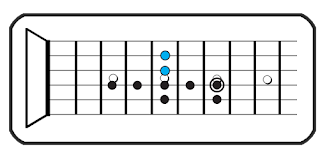Play These 7 Notes All Afternoon for Endless Fun! (JAZZ, SOUL, R&B)
In this lesson, I'll be running through a series of 7 notes that can work absolutely fantastic for playing and building additional exercises or personalized melodies from.
Most important, this exercise will help you explore how to develop options from this group of notes so that you can either use it all over the neck for interesting scale exercise, or use it within a piece of music that you're composing.
ONE COOL EXERCISE:
There are many types of scale and arpeggio exercises for creating melody, but if the ones you're doing are only focusing on playing random notes (that don't offer several added options), then you're not looking at the complete picture.
This lesson has several added options to take an afternoon of guitar playing into a direction that's both fun and motivating.
In this post we're going to talk about a classic Jazz Soul R and B idea that can make for a great afternoon of fun on the guitar.
This study is reminiscent of riffs that have occurred in songs by everyone from Ray Charles to Eric Clapton, Duke Ellington, as well as, Led Zeppelin.
The study is based on a series of 7-notes surrounding a neighboring chord that can produce a ton of options for guitar players when it’s performed in different positions all over the neck.
Let’s get things started by introducing the framework of how this series of notes sits on the guitar.
THE UNDERLYING SCALE LAYOUT:
The first note layout that I want to cover with this idea is based on five notes taken from out of the minor scale. We’ll set things up on the guitar from the 7th fret of the 4th string at the note of “A.”
Example 1a). Note names
The tones that we’re starting with are all based from out of a root of “A” at the 4th guitar string. They come together to establish a scale that’s, “Minor.”
Now that you know the note names, start thinking of this series of tones (from the key of “A Minor”), as a geometrical shape on the neck.
We could use the geometry of this note pattern to start branching out into other positions. The diagram below shows how this note group would look as a scale pattern. Once you see this layout as a pattern, you can move it anywhere along the span of the fingerboard.
Example 1b). Note Geometry
Move the five notes of the “Minor” Scale all along and around the fingerboard.
I wanted to take a minute to let you know, that if you want to learn even more about scales and theory I have a great offer for you.
With any donation over $5, or any merchandise purchase from my Tee-Spring store, I’ll send you free copies of THREE of my most popular digital handouts.
One is called, “Harmonized Arpeggio Drills” (it’ll train you on developing your diatonic arpeggios).
Another one is my “Barre Chord” Handout which includes a page showing all the key signatures along with a chord progression that applies barre chords.
Plus, you’ll get my Notation Pack! It has 8 pages of important guitar worksheets for notating anything related to; music charts, guitar chord diagrams, and TAB.
As a BONUS, (from my "Over 40 and Still Can't Play a Scale" video), I'll also throw in a breakdown of all of the chords that are diatonic to the "F Major" scale.
As an EXTRA BONUS for my Phrygian Dominant video, I'll also throw in a breakdown featuring all of the chords that are diatonic to the Phrygian Dominant scale.
Just send me an email off of the contact page of CreativeGuitarStudio.com to let me know about either your donation or your Merchandise purchase and I’ll email you those digital handouts within 24 hrs.
____________________________________________________
EXPANDING ON THE SOUND:
The next step with our scale shape will be converting its sound to behave more like a Jazz, or an R and B idea. What we’re going to do with these notes is add some passing tone options around the set up that we’ve established so far.
Example 2).
Adding passing tones to open up our options and create new directions for Jazz, Funk, Soul and R and B musical sounds.
If we move through the scale tones, (and those passing tones), while basing the layout of the movement upon the shape of a neighboring “Minor” chord, we can start using the chord tones (of that minor chord), around the notes of this scale to create some really cool music.
Let's begin by learning the shape for this neighboring chord as well as learn more about how all of this can work to our advantage…
The Neighboring Chord:
Example 4).
Adding the first tone of the neighboring chord.
Example 5).
Adding the second tone of the neighboring chord.
Example 6).
Adding the third tone of the neighboring chord.
Example 7).
Adding any possible open strings
So the take home message (when it comes to playing around one afternoon with these seven notes – having some fun), is how quickly and easily they can be used to create fun melodic ideas.
It barely takes any time at all, and you can be working through some great melodic sounds along a number of really interesting chord ideas as well.
So, try this out. It’s easy to do, and once you start trying this, you’ll find out how cool it can be to use it in your playing. Plus, if you ever need an extra song part (for a song you’re composing), this idea can work great!















